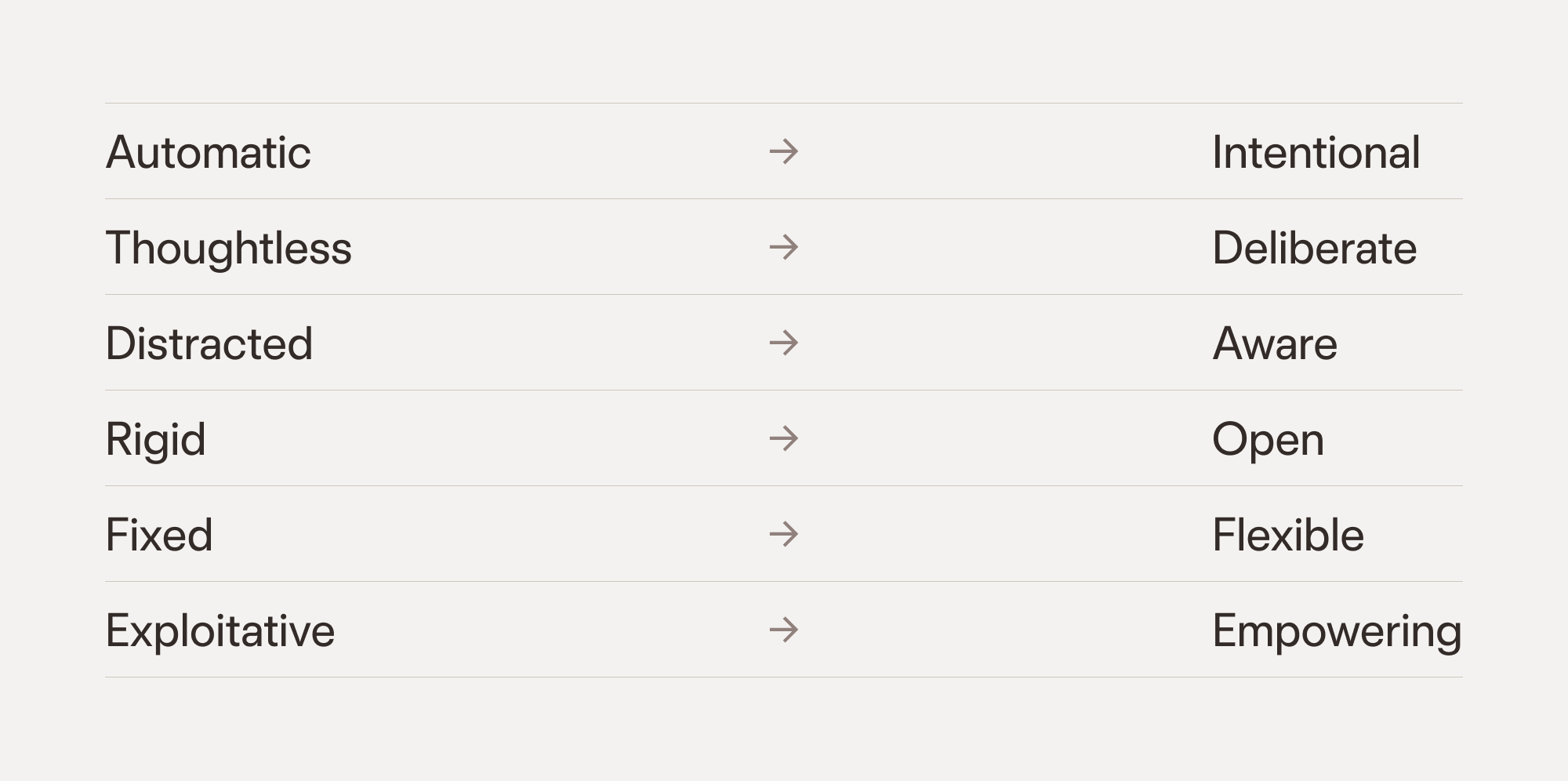Attention to Intention
Written by • • 5 min read
What if every time you picked up your phone, it helped you focus on your goals rather than distracting you? How would our lives change if technology served our intentions instead of demanding our attention?
As a leader in the tech industry, I have seen first-hand how our digital landscape is both a blessing and a curse. It provided access to the world, new experiences, cultures, perspectives, and knowledge. But it has also come to rule our attention, with devices, digital tools and apps inextricable from our daily lives.
With the recent advancements in AI and the new tools and outputs it brings, we face a unique opportunity: to make technology a tool for mindful, deliberate engagement with the world. After all, those of us with the privilege to shape how we use technologies carry significant responsibility to act on our knowledge.
Addictive technologies
As far back as 2005, a study for Hewlett Packard led by London’s Institute of Psychiatry [1] found that persistent interruptions resulted in a temporary 10-point decline in participants’ IQ. In particular, the trials showed that emails have an addictive, drug-like grip.
Fast-forward 20 years, and digital distractions have increased manifold. Today, people in the UK spend half their free time watching, interacting and engaging with digital content — 26 hours per week, of an average of 50 hours of leisure time. [2]
Combined with the proliferation of AI to make apps, digital experiences, and content feel more intuitive and – arguably – more addictive, we are facing consequences for our mental health, social relationships and the environment. At the very least, it is a waste of precious resources; of our time and attention, opportunities to engage with our physical and natural world, and the planetary resources that fuel our usage.
But what if we could flip these dynamics on their head? Instead of mindlessly using AI to supercharge a broken system, could we apply it in a deliberately mindful way?
The promise of mindful AI
The last 18 months has seen enormous leaps in the creative abilities of AI. However, in a world where our limited attention and resources are met with infinite information and countless options, it's AI’s intrinsic reductive abilities to filter, summarise, reformat, optimise, adjust, and hold context that feel far more transformative.
At Normally, we focus on the mindful application of AI, which is an approach to product development, innovation, and engineering that harnesses these intrinsic qualities of artificial intelligence to the benefit of humans, society and the planet.
Dr. Ellen Langer, professor of psychology at Harvard University, has studied both mindlessness and mindfulness for most of her career. She identified what constitutes a mindful engagement with the world, and generated a body of evidence of its benefits; including better mental and physical health, social cohesion, resilience and productivity.
Building on her insight, we can start to imagine a shift in how we engage with digital technologies and experiences:

Thanks to technological advancements, we are now able to leverage AI to help us act on our intentions – whether they are individual or collective, short- or long-term.
Can we imagine a browser that helps you achieve an outcome without distraction? Social media that re-engages you with the real world? Devices that help you stay present? Tools that elevate human contribution? Systems that optimise for energy reduction?
Designing for intention
We, as leaders in the tech industry, are presented with an opportunity to create a new generation of products and services that aid our intentions, rather than hinder our goals. At the same time, there are challenges to how we work, build, and integrate more mindful uses of AI that we must address.
1. The business challenge
Many of the world’s largest organisations are fuelled by advertising revenue, and the currency in advertising is eyeballs and engagement. The attention economy with all its problems is a consequence of an environment that optimises for these currencies. Can we build an alternative, healthier, more equitable and sustainable internet by exploring and committing to new business models?
To get there, we must embrace exploration, taking an open, curious approach to AI integration in which we actively seek to understand the full range of opportunities AI presents, critically examine the limitations and potential pitfalls of AI, and thoroughly consider the broader implications for businesses, products, and society.
2. The engineering challenge
The last digital transformation was led by engineering, and rightly so. When the task is to create complex infrastructure, a top-down approach in which the engineering team functions as the architect is sensible. In the future, however, we cannot expect to make the most of the potential of AI unless we consider human factors, experience, and business strategy as part of our engineering decisions. How might we take a more holistic approach in which we consider human and societal implications — both inside and outside of our organisation?
We must respond with collaboration over competition. Breaking down silos is crucial for speed and internal adoption; this starts with creating space for cross-functional teams that bring diverse perspectives to the table. We must encourage dialogue between technologists, ethicists, business strategists, and end-users so ideas can flow freely across traditional organisational boundaries.
3. The adoption challenge
As humans living in the digital age, we have gotten accustomed to the status quo and have prized small, short-term gains, sometimes at a greater long-term cost. It will be tempting to recreate everything we already know, use, and expect by augmenting it with AI. This could inevitably supercharge many of the problems we have seen in the last decades. How can we align our technologies, tools, and services better with people’s deeper, long-term intentions?
This requires a commitment to the practical application of AI. Moving from concepts to real-world practice is essential to make a genuine, measurable impact. Let’s prioritise evidence-based decision making over assumptions or speculation, utilising rapid prototyping and testing, and iterative approaches that allow for real-world feedback and quick adjustments.
The path forward
To pave the way for a more mindful technological future is not without its challenges, but the potential rewards are immense. By harnessing AI’s capabilities in a deliberate and thoughtful manner, we can create a digital ecosystem that enhances our lives, rather than detracts from them.
This mindful approach also aligns with our human values and aspirations – it’s a commitment to creating and supporting technologies that enhance our focus, nurture our relationships, and respect our planet.
Whether you are a tech innovator, a business leader, or an everyday user, you can play a part in this transformation. We are in a pivotal moment in technological history. We have a chance to build a digital world that empowers rather than distracts, connects rather than isolates, and serves our highest aspirations as individuals and as a society.
Together, we can transform our digital landscape into one that truly serves humanity's best interests. The future of technology – and our relationship with it – is in our hands. Let’s make it a mindful one.
